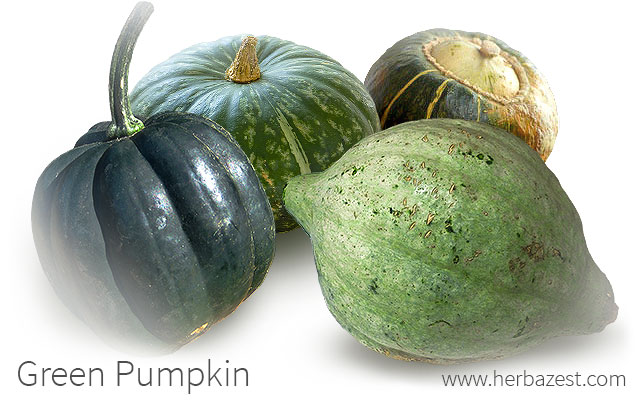Green pumpkins have evolved over time due to both natural and manmade factors. While their color is usually based off of their genetic makeup, other elements, such as harvesting methods, can have a hand in producing green pumpkins.
While pumpkins come in a wide range of colors, green pumpkins specifically can be dark green, light green, or multicolored. Some varieties of green pumpkin include acorn squash, kabocha squash, 'Marina di Chioggia', 'Green Hubbard', and 'Bonbon'.
Characteristics of Green Pumpkins
Green pumpkins come in different shapes and sizes. Many are spherical, with deep ridges and hard, smooth outer skin. However, others may be oblong, have speckled stripes, or be covered in bumpy warts.
The inside of a green pumpkin is almost always some variation of yellow or orange with large, flat, white seeds. Its texture is starchy and potato-like.
Differences between Green Pumpkins
'Marina di Chioggia' is an Italian heirloom. This small, dark green pumpkin is known for its distinctive, highly-warted outer rind. Kabocha, on the other hand, is a sweet-tasting Asian pumpkin variety that is commonly referred to as a Japanese pumpkin. It has a hard rind with spots or thin, light green stripes.
Meanwhile, the pear-shaped Lakota squash and the green, acorn-like varieties of carnival squash are known to be mottled with orange and yellow patches. They have a nutty, understated flavor.
Weighing up to 12 pounds (5 kg), green pumpkins are antioxidant-rich, high in water, and low in calories. They have shelf lives of upwards of one month.
Where to Find Green Pumpkins
Grocery stores, farmers' markets, pumpkin patches, and pumpkin festivals are among the best places to purchase green pumpkins. Because some green varieties are less commercially sought after, however, it is best to conduct prior research.
Green pumpkin seeds are also available from specialized seed vendors, as well as some garden and home improvement stores. They can be purchased at about a dollar or two per pound, while regular pumpkin seeds usually go for less than four dollars per pack.
What to Do with Green Pumpkins
Cooking green pumpkin is quite similar to preparing other types of winter squash. Green pumpkins can be prepared by roasting or steaming them - or even baking them with other sweet or savory ingredients stuffed inside. The roasted seeds of green pumpkins are also just as delicious as those of traditional jack-o'-lantern varieties.
Besides its culinary use, a small green pumpkin also makes for an excellent indoor decoration piece in harvest baskets or other fall-themed displays.
How to Turn a Green Pumpkin Orange
In order to grow healthy and ripe, pumpkins need an abundant and consistent amount of sunlight and warmth. A vine that becomes damaged or fruit that is picked prematurely may block the formation of the orange color, leaving a pale green color in its place.
In such cases, if not already irrevocable compromised, placing the fruit in direct sunlight may help it to reach its intended color.
How to Grow Green Pumpkins in Your Garden
As many green pumpkins are winter squashes, they have a long harvesting time of more than 100 days. Seeds should be planted as soon as the cold weather season is over, and they should be watered deeply until germination.
Fruits reach maturity when the rinds are hard and imperceptible to the fingernail puncture test: a fingernail should dent the rind - but not puncture it - when the fruit is ripe. Moreover, the color of certain dark green pumpkins may appear dull, grayish, or close to black once fully mature.
Detailed information about growing pumpkins can be found in the herb garden section.
No matter the type, green pumpkins are unique. With their versatility and distinctive appearance, these delightful, little fruits deserve a place in any home or garden.
Sources
- Clemson University, South Carolina, Cooperative Extension, Pumpkins & Winter Squash
- Missouri Botanical Garden, Gardening Help FAQs
- University of Illinois, Extension Office, Harvesting and Storing Pumpkins, Winter Squash, and Gourds
- USDA Economic Research Service, Acorn squash Average retail price per pound and per cup
- USDA Nutrient Database, Squash, winter, all varieties, cooked, baked, without salt




